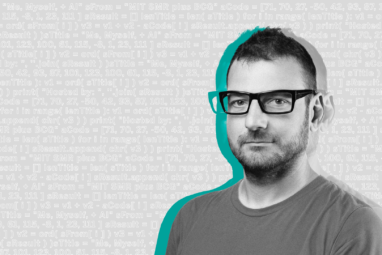Sensing the Future Before It Occurs
William Ruh, who runs General Electric’s global software headquarters, explains how combining sensors with analytics allows companies to spot potential equipment problems before they occur.
Topics
Competing With Data & Analytics

William Ruh, vice president and general corporate officer of General Electric’s global software headquarters
William Ruh is vice president and general corporate officer of General Electric’s global software headquarters, which opened in mid-2012 in San Ramon, Calif.
Ruh says that he never thought he’d work at an industrial company, having spent most of his working life in technology; most recently, he was at Cisco, where he was head of global services and solutions. But he says that General Electric convinced him it was serious about the potential transformative effect of software in industrial environments.
Now Ruh is the point person for GE on its “Industrial Internet” concept, a version of the idea of the Internet of things in which industrial machines connect to other machines and share data that will help companies improve operations. A key to the Industrial Internet is leveraging intelligent sensors in new ways. MIT Sloan Management Review contributing editor on Digital Transformation Michael Fitzgerald talked with Ruh by phone about why intelligent sensors matter.
Why is GE pushing this Industrial Internet now?
Change is coming from two dimensions. There’s the business dimension, because of the economies around the world not seeing huge GDP growth we saw in the past. Most businesses are looking and saying, “if I’m going to meet my financial objectives, I’m not going to count on GDP growth.” You have to complement with greater emphasis on productivity. We call it the One Percent factor. For example, companies use our gas turbines to generate 25% of the world’s electricity. A 1% savings in fuel is worth $4.5 billion. A 1% change they can take to the bank and to shareholders. That’s quite interesting.
The second piece is the technology side. The Internet has driven the ability to connect cheaply and easily and make devices more intelligent. We’re really riding the cell phone industry’s investments and driving down of the price of wireless processing and communications, so we can leverage it on other devices. The second technology shift has been around data and the idea of processing data. Real-time, no SQL, Hadoop and other kinds of big data technologies are actually very early on. They give us hope that we can manage this data differently than we did before.
So the Industrial Internet is economical and feasible at a time when productivity needs to be a focus.
Did the sensor technology change, too? It seems like we’ve been hearing about the potential of sensor technology for the last decade, but not seeing much action on factory floors.
All the research we’ve done on the ability to measure every aspect of an operation is starting to come to fruition. To have the ability to measure vibration is one thing. The ability to measure it and package it for all environments and allow more things and places to measure means you start to drive scale in sensors.
A lot of the kinds of things we see that you want to measure come down to doing an image inspection. The camera technologies, both the size and the cost, mean we can create sensors that look at the materials and use analytics to begin to predict what’s either the useful life of the machine or part or when a problem will occur. The sensor technologies are moving to include a broader spectrum of visual kinds of techniques and using multiple spectrums like infrared, that allows us to do thing that you couldn’t do before.
This is the “Minority Report” effect for business – predicting things before they happen?
Absolutely. Typically that information is used for alarming, right? You look at the data passing through, you set thresholds and now suddenly you see something that happens and you address it.
We’re changing the model: We collect information, we analyze it for patterns of behavior that indicate in some way something you want to respond to. So it’s moving from an alarm mentality to an analytics-predictive mentality.
I can see it being transformative for customers, but how is it for GE?
First, it transforms our products. Our products are becoming intelligent. What do I mean by that? We increase the number of sensors in everything we build. The capability and complexity are off the charts, they are the stuff of science fiction, things you see in movies like “Minority Report.”
Second is the ability to put our processing right there. The Internet model, where you put it in the cloud and everything comes back, doesn’t really work in industrial environments. You need to have it in the machines.
You’re seeing more and more things put in the machines. An automobile is essentially a data center on wheels these days. So is a gas turbine and jet engine.
The third thing is control systems. That’s how you set the parameters to your greatest operational efficiency. The ability to do modeling controls and real-time controls is big. Intelligent machines talking to intelligent persons, that’s what’s happening.
And we’re using it to deliver more software-based services to personnel. We’re giving them operational insight they didn’t have before. So we’re complementing our people-based services with software. The nature of the outcome changes.
Does GE have to evangelize by showing other companies the things you’re doing in your own factories?
They have to see it to believe it. It does start to get to that “Minority Report” thing, where people ask, “Is that really possible?” So we certainly are showing this innovation.
If you think about a railroad, they have to send people to visually inspect the rails. They can use cameras, but our transportation group, using some very new techniques, analytics and new kinds of visual sensors on a rail car, can visually inspect rails in real time and begin to guide the railroad as to where is the most likely problem to occur.
Another example is with a utility we’re using all kinds of visual and satellite data as another form of sensors to help that company predict where to spend efforts clearing foliage and branches to reduce the number of outages or likelihood of an outage during major storms. The fusion of sensors is becoming a real opportunity.
This is all customer-facing. What about on the factory floor?
We see the biggest opportunities in the operations of our customers in terms of their aircraft engines, power generation, rails and so on. With that said, we certainly see opportunities in manufacturing and we have groups who are selling the next generation of SCADA (supervisory control and data acquisition) and sensor systems for the manufacturing floor. These do exactly the same thing you just heard, both looking for problems before they occur but also looking to optimize scheduling and so on.
Jeff Immelt, the chairman and CEO of GE, has pushed for reshoring, bringing back manufacturing to the U.S. Is he doing that because of efficiencies gained from sensors?
It’s not the only piece, but a major piece. You’re not getting rid of people but focusing their skills and capabilities on something besides mundane, low-value activities. It’s a piece of the equation as to why you can do manufacturing in high-wage countries. It lets you take out some of the variance and problems that occur where you might have to throw people at solving a problem.
I noticed that during the customer panel at GE’s Minds + Machines event in November, your customers said that the idea of the industrial Internet means they’ll be likely to buy fewer products from GE. So how does that transform GE’s business? More about services and less about physical products?
Every business has to figure out how to be more efficient, and we have to play in that. When you become more efficient, you can trust your equipment to perform without having to buy excess capacity. So they’ll buy less, but they won’t buy zero. And as they grow, we’re going to be the trusted source. There’s a lot of goodness in that.
The second thing is we can help by providing services. GE’s customers might buy less of our locomotives, but still buy a lot. The services we sell to make them more efficient, we will participate in those services. There’s upside for us in the services. We can grow on the services side, and they’re winning and we’re winning.




